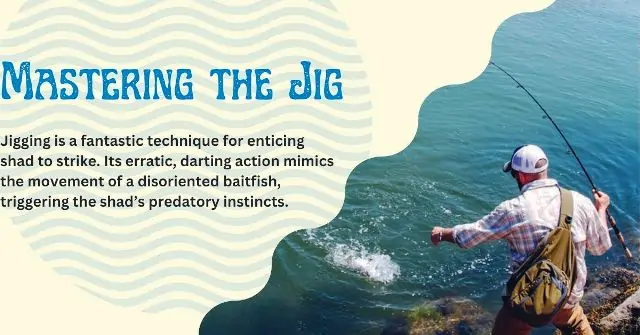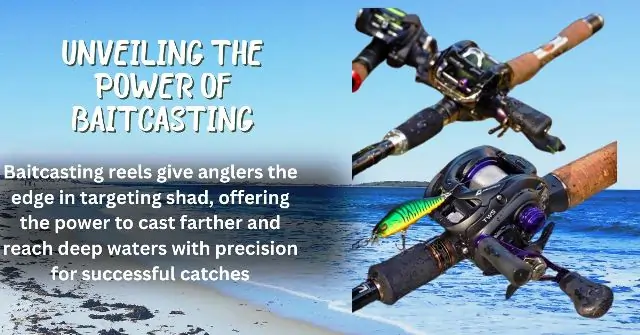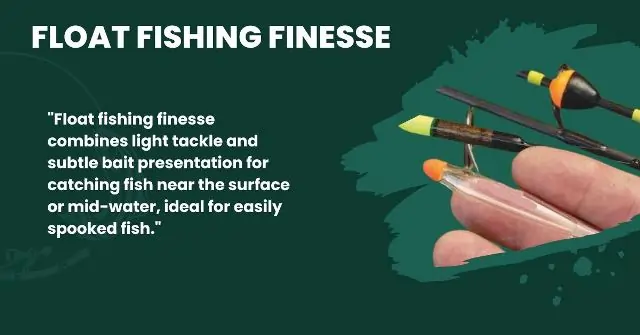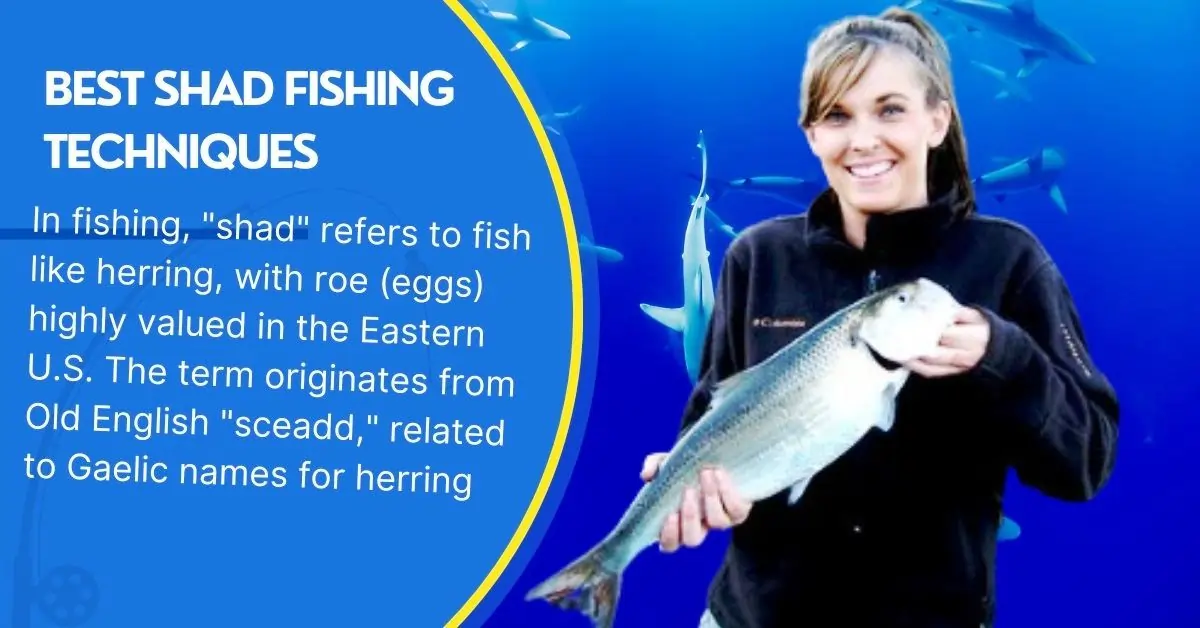The allure of shad fishing lies in the silver flash of a shad leaping out of the water and its fierce battle pushing the limits of your rod. These fierce combatants, often referred to as American Shad (Alosa sapidissima), are highly sought-after by many fishermen due to their crucial role as baitfish for larger predators as well as their thrilling fights. But chance alone won’t suffice to become a skilled shad fisherman. Here’s when understanding the finest shad fishing methods becomes useful. You may turn your shad fishing experience from sporadic encounters to regular success by learning their habits and using appropriate tactics. Prepare to master shad fishing so you can take command of your next excursion!
5 Proven Best Shad Fishing Techniques
Mastering the Jig

Jigging is a fantastic technique for enticing shad to strike. Its erratic, darting action mimics the movement of a disoriented baitfish, triggering the shad’s predatory instincts.
There are two main jig types that excel for shad:
- Leadhead Jigs: These simple yet effective jigs feature a weighted head and a soft plastic body. The weight helps cast the jig farther and reach deeper water where shad often lurk. Choose lighter jigs (1/8 oz to 1/4 oz) for shallower areas or when targeting smaller shad.
- Bucktail Jigs: These jigs boast a leadhead adorned with a bucktail skirt, which creates enticing vibrations and flashes in the water as you jig. Bucktail jigs can be particularly effective in attracting shad in low-light conditions or murky water.
Now, let’s talk about the jigging dance! The key is to create a lifelike presentation. Here’s a basic approach:
- Lower the jig: Let your jig sink to the desired depth where shad are likely to be cruising.
- Snap and Lift: Give your rod tip a sharp upward flick, followed by a slight pause. This creates a darting motion that simulates a fleeing baitfish.
- Reel Up: As the jig flutters down, slowly reel in the slack line, keeping your line taut. Repeat steps 2 and 3, adding variations in speed and rhythm to entice curious shad.
With a little practice, you’ll master the jigging rhythm and soon be luring feisty shad to your line!
Unveiling the Power of Baitcasting

For anglers seeking ultimate control and accuracy when targeting shad, baitcasting unlocks a world of possibilities. Here’s why:
- Reaching the Strike Zone: Baitcasting reels allow you to spool heavier fishing line compared to spinning reels. This translates to casting farther and reaching deeper water columns where shad often reside, especially near dams or deeper sections of rivers.
- Pinpoint Targeting: The baitcasting setup offers more direct line control, allowing for precise casts and presentations. This is crucial for targeting specific areas within a shad school or strategically placing your lure around underwater structures that shad might be attracted to.
Now, let’s explore the essentials of baitcasting for shad:
Gear:
- Baitcasting Rod: Opt for a medium-power baitcasting rod with a moderate action. This provides the balance of strength to handle feisty shad and some flexibility for casting accuracy.
- Baitcasting Reel: Choose a baitcasting reel with a comfortable grip and a good gear ratio for efficient retrieves.
Lure Selection:
- Crankbaits: These hard-bodied lures with diving bills are excellent choices for reaching specific depths and triggering shad strikes with their wobbling action. Select crankbaits with medium diving depths to explore shad holding areas.
- Spoons: These versatile metal lures flash and vibrate enticingly in the water, attracting shad attention. Opt for smaller, lightweight spoons suitable for casting accuracy.
Technique:
Mastering the baitcasting technique takes some practice, but the basic steps are:
- Grip and Cast: Hold the rod firmly with your non-dominant hand and spool some line off the reel with your thumb. Then, with a flick of your wrist and a controlled release of the spool, propel your lure towards the target area.
- Retrieve: Once your lure reaches the desired depth, begin a steady retrieve, keeping your rod tip pointed slightly down. This creates a lifelike swimming action for the lure.
- Feeling the Bite: Stay alert for any sudden tugs or changes in line tension as these could signal a shad strike. Be prepared to set the hook with a firm but controlled motion.
With a bit of practice and the right setup, baitcasting can become your weapon of choice for strategically targeting shad and experiencing the thrill of their powerful fight!
Trolling Tactics for Trophy Shad

Trolling is a fantastic technique for covering large areas of water and enticing bigger, trophy-sized shad to strike. Here’s what makes it so effective:
- Covering Ground: By steadily trolling your lures behind your boat, you can efficiently explore wide stretches of water where shad might be scattered. This increases your chances of encountering larger, more mature shad compared to stationary fishing methods.
- Tempting Targets: The continuous movement of your lure mimics a fleeing baitfish, triggering the predatory instincts of larger shad. Trolling allows you to maintain a consistent presentation depth, keeping your lure in the strike zone for longer periods.
Now, let’s talk about trolling for trophy shad like a pro:
Speed is Key: The ideal trolling speed for shad can vary depending on water conditions and the specific lure you’re using. Generally, a slower trolling speed (around 1.5 to 2.5 mph) is recommended for shad. This allows the lure to maintain a realistic swimming action and stay within the strike zone for longer.
Lure Arsenal: Here’s a look at some effective trolling lures for trophy shad:
- Shad Darts: These slender lures with realistic shad profiles mimic the shape and movement of baitfish perfectly. They come in various sizes and diving depths, allowing you to target shad at different water levels.
- Inline Spinners: These lures feature a spinning blade that creates flash and vibration as you troll, attracting shad from afar. Choose inline spinners with smaller blades suitable for shad fishing.
Bait Setups: For a more natural presentation, you can even troll live bait like minnows behind a planer board or downrigger. This can be particularly effective for targeting trophy shad, especially during their spawning seasons.
Trolling Tips: Experiment with different trolling speeds, lure variations, and bait setups to see what works best in your specific fishing location. Remember, keeping your line taut and having a sharp hook are crucial for a successful shad hookset while trolling.
By mastering these trolling tactics, you’ll be well on your way to unlocking the secrets of catching trophy shad and experiencing the satisfaction of landing these impressive fighters!
Float Fishing Finesse

In slower currents or tranquil waters, shad can become more cautious about aggressive presentations. This is where the finesse approach of float fishing shines. It allows you to present your bait subtly, enticing these wary shad to strike.
Imagine a gentle breeze carrying your bait across the water’s surface, mimicking a natural morsel drifting downstream. That’s the beauty of float fishing for shad. Here’s a breakdown of the setup:
The Rig:
- Float: Choose a small, lightweight float with good buoyancy. This ensures it won’t spook the shad and allows your bait to drift naturally.
- Line: Opt for light monofilament line (around 4-6 pound test) for minimal visibility in the water.
- Split Shot: A small split shot weight crimped a few feet above the hook adds enough weight to cast your rig effectively and keep your bait at the desired depth.
- Hook: A small, sharp hook (size 6-8) is ideal for shad fishing. Consider using a bait hook for live minnows or a jig head for small soft plastic jigs.
Bait Selection:
- Live Minnows: Small minnows are a natural choice for float fishing. Their lifelike appearance and subtle movements are irresistible to curious shad.
- Small Jigs: For a more durable bait option, small soft plastic jigs can be effective. Choose jigs that mimic insects or other small prey that shad might feed on.
Presentation:
- Cast your float rig upstream and allow it to drift naturally with the current or wind.
- Adjust the split shot placement to control the depth at which your bait drifts. You want it to be just above the bottom or within the shad’s feeding zone.
- Stay attentive! A slight bob or a disappearance of the float can indicate a shad strike. Be prepared to set the hook with a gentle lift as shad can have softer mouths.
Float fishing for shad requires patience and a delicate touch. But with the right setup and a calm presentation, you can unlock a world of shad fishing success in those calm, serene waters.
Shad Savvy: When, Where, and How to Find Them
Shad Savvy: Timing and Location:
Knowing when and where to find shad is key to maximizing your fishing experience. Here’s a breakdown of the shad’s habits to help you target them effectively:
Prime Shad Season: Shad are migratory fish, following predictable patterns throughout the year. Their peak activity for anglers typically falls in two seasons:
- Spring Rush: As spring arrives, shad head upstream towards freshwater rivers and streams to spawn. This period, often coinciding with the blooming of dogwood trees (depending on your location), offers a fantastic opportunity to target these energetic fish.
- Fall Feast: After spawning, shad return downstream towards saltwater in the fall. During this migration, they tend to gather in larger schools, making them easier to locate and potentially leading to exciting catches.
Time of Day: Similar to many fish, shad tend to be more active during low-light conditions. Targeting them at dawn and dusk can significantly increase your chances of success. During these periods, shad become more active feeders, searching for food in the cooler, calmer water.
Finding Shad Havens: Now that you know when to go, let’s explore where to find these prized fish:
- Moving Water: Shad are drawn to areas with some current, such as moving water near dams or the outflow areas of lakes and rivers. These currents help them navigate and locate food sources like plankton and small insects.
- Deeper Pools: In calm stretches of rivers, shad often congregate in deeper pools where cooler, oxygen-rich water is present. Look for areas with structure like submerged logs or rock piles, which can attract shad seeking shelter or shade.
- Saltwater Inlets: During their migrations, shad may pass through saltwater inlets as they transition between freshwater and saltwater environments. Targeting these areas during spring and fall migrations can be productive, especially if you can identify shad schools using sonar or visual cues like surface activity.
A Note on Tides (Optional): While shad activity isn’t solely dependent on tides, some anglers believe that a slight change in current associated with tidal movements can trigger increased feeding activity in shad, particularly during periods of moving water. So, if you’re fishing in areas with tidal influence, keeping an eye on the tide chart might be an extra tip worth considering.
Shad Identification
Knowing your target is key to successful fishing, and shad are no exception. Luckily, these fish boast some distinctive features that make them easy to identify on the water:
- Streamlined Silhouette: Shad have an elongated, herring-like body. This sleek shape allows them to be agile swimmers, often darting and flashing through the water.
- Forked Tail Fin: Take a closer look at the tail. Shad have a deeply forked tail fin, which helps propel them with powerful bursts of speed. Imagine a fish with a dinner fork for a tail, that’s the key feature!
- Single Dorsal Fin: On the top of their back, shad have a single, prominent dorsal fin. This fin helps them maintain stability and direction as they navigate through the water.
FAQ on ” Best Shad Fishing Techniques
Q: Can you eat shad fish?
A: Yes, shad are edible and known for their distinctive, rich flavor
Q: Does bass eat shad?
A: Absolutely, shad are a common and favorite food for bass
Q: Do sharks prey on shad?
Yes, sharks do eat shad, especially when they’re schooling in open waters.
Q: Is shad used for caviar?
A: Yes, shad roe is considered a delicacy, similar to caviar.
Conclusion:
We’ve explored five proven shad fishing techniques – jigging, baitcasting, trolling, float fishing, and fly fishing (optional) – each offering unique advantages. Remember, shad behavior and preferences can vary depending on location and season. So, experiment with these techniques and see what works best for your local shad population.
Don’t be afraid to get creative and combine elements from different techniques. The key is to understand shad behavior, present your bait or lure enticingly, and be prepared for the fight! Now that you’re armed with shad savvy and these effective fishing methods, it’s time to put your knowledge to the test. Grab your rod and reel, head out to the water, and dominate your next shad fishing trip!
